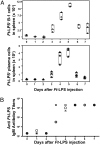Antigen-specific B-1a antibodies induced by Francisella tularensis LPS provide long-term protection against F. tularensis LVS challenge
- PMID: 19251656
- PMCID: PMC2657382
- DOI: 10.1073/pnas.0813411106
Antigen-specific B-1a antibodies induced by Francisella tularensis LPS provide long-term protection against F. tularensis LVS challenge
Abstract
Francisella tularensis (Ft), a gram-negative intracellular bacterium, is the etiologic agent of tularemia. Infection of mice with <10 Ft Live Vaccine Strain (Ft LVS) organisms i.p. causes a lethal infection that resembles human tularemia. Here, we show that immunization with as little as 0.1 ng Ft LVS lipopolysaccharide (Ft-LPS), but not Ft lipid A, generates a rapid antibody response that protects wild-type (WT) mice against lethal Ft LVS challenge. Protection is not induced in Ft-LPS-immunized B cell-deficient mice (muMT or JhD), male xid mice, or Ig transgenic mice that produce a single IgH (not reactive with Ft-LPS). Focusing on the cellular mechanisms that underlie this protective response, we show that Ft-LPS specifically stimulates proliferation of B-1a lymphocytes that bind fluorochrome-labeled Ft-LPS and the differentiation of these cells to plasma cells that secrete antibodies specific for Ft-LPS. This exclusively B-1a antibody response is equivalent in WT, T-deficient (TCRalphabeta(-/-), TCRgammadelta(-/-)), and Toll-like receptor 4 (TLR4)-deficient (TLR4(-/-)) mice and thus is not dependent on T cells or typical inflammatory processes. Serum antibody levels peak approximately 5 days after Ft-LPS immunization and persist at low levels for months. Thus, immunization with Ft-LPS activates a rare population of antigen-specific B-1a cells to produce a persistent T-independent antibody response that provides long-term protection against lethal Ft LVS infection. These data support the possibility of creating effective, minimally invasive vaccines that can provide effective protection against pathogen invasion.
Conflict of interest statement
The authors declare no conflict of interest.
Figures



References
-
- Dennis DT, et al. Tularemia as a biological weapon: Medical and public health management. JAMA. 2001;285:2763–2773. - PubMed
-
- Elkins KL, Cowley SC, Bosio CM. Innate and adaptive immune responses to an intracellular bacterium, Francisella tularensis live vaccine strain. Microbes Infect. 2003;5:135–142. - PubMed
-
- Borghesi L, Milcarek C. Innate versus adaptive immunity: A paradigm past its prime? Cancer Res. 2007;67:3989–3993. - PubMed
-
- Baumgarth N, Tung JW, Herzenberg LA. Inherent specificities in natural antibodies: A key to immune defense against pathogen invasion. Springer Semin Immunopathol. 2005;26:347–362. - PubMed
Publication types
MeSH terms
Substances
Grants and funding
- AI57168/AI/NIAID NIH HHS/United States
- R56 AI076434/AI/NIAID NIH HHS/United States
- AI43603/AI/NIAID NIH HHS/United States
- U54 AI157168/AI/NIAID NIH HHS/United States
- R01 GM050870/GM/NIGMS NIH HHS/United States
- Y1 AI-6153-01/AI/NIAID NIH HHS/United States
- R01 AI076434/AI/NIAID NIH HHS/United States
- R56 AI018797/AI/NIAID NIH HHS/United States
- AI18797/AI/NIAID NIH HHS/United States
- R37 AI018797/AI/NIAID NIH HHS/United States
- GM50870/GM/NIGMS NIH HHS/United States
- Y01 AI006153/AI/NIAID NIH HHS/United States
- AI076434/AI/NIAID NIH HHS/United States
- R01 AI018797/AI/NIAID NIH HHS/United States
- R01 AI043603/AI/NIAID NIH HHS/United States
- U54 AI057168/AI/NIAID NIH HHS/United States
LinkOut - more resources
Full Text Sources
Other Literature Sources
Molecular Biology Databases

